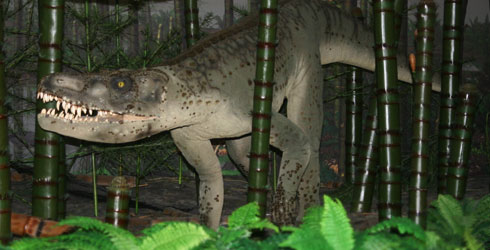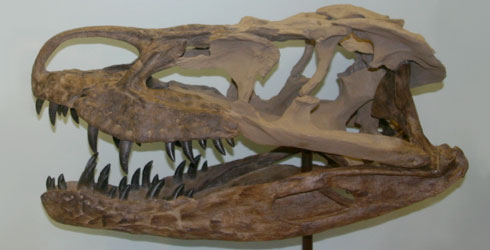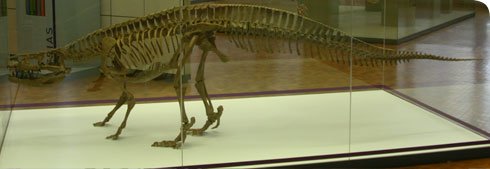Batrachotomus kupferzellensis
Batrachotomus kupferzellensis was a large, 4-legged, carnivorous reptile. It measured approximately 4 metres in length.
Unlike most modern reptiles, Batrachotomus kupferzellensis stood with its body clear of the ground, its limbs held almost directly beneath its body.
It had a row of paired bony plates running along the middle of the back and tail.
Batrachotomus kupferzellensis is the only species in this genus of extinct archosaurian reptiles from the Triassic period. Its fossil remains were first excavated in 1977, from rocks of Ladinian age - approximately 230–237 million years old. It was not formally identified and described until 1999.
Although many terrestrial reptiles of Triassic age are known only from very imperfectly preserved and incomplete fossils, the type series of Batrachotomus kupferzellensis includes some exceptionally well-preserved remains of at least 5 individuals, so almost every bone in the body is known.
Species detail
-

Taxonomy
Batrachotomus kupferzellensis translates as the ‘Kupferzell frog-slicer’. Find out how it gained this name, and read more about its evolution and crocodilian relatives.
-

Distribution and ecology
Batrachotomus kupferzellensis is the largest terrestrial carnivore known to have inhabited western Europe during the Middle Triassic. The reptile was part of a complex ecosystem that scientists have been able to piece together and describe thanks to well-preserved fossils found in Germany in 1977.
-

References
Get reference material for Batrachotomous kupferzellensis.
Images

A reconstruction of Batrachotomus kupferzellensis and its habitat, on display in the Museum für Naturkunde, Stuttgart.
© David Gower
A close up of the head of the reconstruction of Batrachotomus kupferzellensis on display in the Museum für Naturkunde, Stuttgart.
© David Gower
One of the well-preserved specimens of Batrachotomus kupferzellensis, showing a series of articulated neck vertebrae and some skull and limb bones.
© David Gower
The tall narrow skull of Batrachotomus kupferzellensis is equipped with large, serrated, blade-like teeth, indicating that it was a carnivore.
© David GowerAbout the author
A word from the author
"This species is the best-known of this type of extinct reptile. I have spent several years working on the fossil specimens. I spent 2 years (1995–96) as a postdoc at the Universität Tübingen, Germany researching Triassic archosaurian reptiles.
I was fortunate to be granted permission by Rupert Wild to work on the fantastic Kupferzell material at the Museum für Naturkunde, Stuttgart. Although I formally described Batrachotomus kupferzellensis, this was the realisation of a lot of work by other people on the discovery, preparation and curation of this material, and other research on the geological and ecological setting of the fossil locality."
Toolbox
Glossary
Archosaurs
Greek: 'ruling lizards'. A group that first appeared in the Triassic whose living representatives include modern birds and crocodiles. This group also includes pterosaurs and dinosaurs, as well as several other extinct groups.
Rauisuchia
A poorly-known assemblage of large predatory Triassic archosaurs.
Triassic
A geologic period that extended from about 250 to 200 million years ago.

